
Hevea is a genus of flowering plants in the spurge family, Euphorbiaceae, with about ten members. It is also one of many names used commercially for the wood of the most economically important rubber tree, H. brasiliensis. The genus is native to tropical South America but is widely cultivated in other tropical countries and naturalized in several of them. It was first described in 1775.
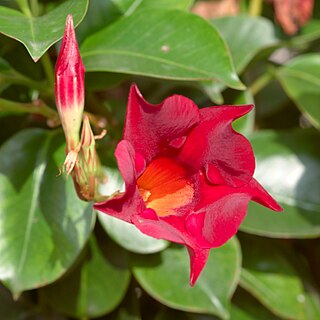
Mandevilla is a genus of tropical and subtropical flowering vines belonging to the family Apocynaceae. It was first described as a genus in 1840. A common name is rocktrumpet.

Dalechampia is a genus of plant of the family Euphorbiaceae and of the monogeneric subtribe Dalechampiinae. It is widespread across lowland tropical areas primarily in the Americas with smaller numbers of species in Africa, Madagascar, and southern Asia. Additional new species are still being described and several are very rare and at risk of extinction.

Pouteria is a genus of flowering trees in the gutta-percha family, Sapotaceae. The genus is widespread throughout the tropical Americas, with outlier species in Cameroon and Malesia. It includes the canistel, the mamey sapote, and the lucuma. Commonly, this genus is known as pouteria trees, or in some cases, eggfruits.
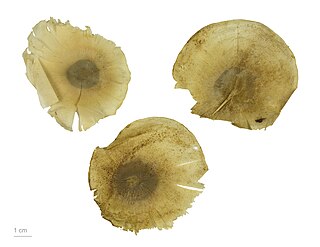
Aspidosperma is a genus of flowering plant in the family Apocynaceae, first described as a genus in 1824. It is native to South America, Central America, southern Mexico, and the West Indies.
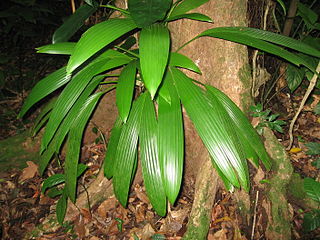
Asplundia is a genus of plants belonging to the family Cyclanthaceae. They are distributed in the Neotropical realm from southern Mexico to southern Brazil.

Aegiphila is a genus of flowering plants in the mint family, Lamiaceae, first described in 1763. It was formerly classified in the Verbenaceae. It is native to Mexico, Central America, South America, the West Indies, and Florida.
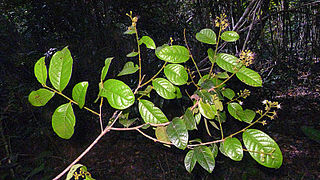
Hirtella is a genus of 110 species of woody trees in family Chrysobalanaceae. It was first described as a genus by Linnaeus in 1753. Hirtella naturally occurs in tropical forests throughout Latin America, the West Indies, southeast Africa, and Madagascar. The flowers are mainly pollinated by butterflies.

Syngonanthus is a genus of plant in family Eriocaulaceae. It is native to tropical Africa and to Latin America.

Axonopus is a genus of plants in the grass family, known generally as carpet grass. They are native primarily to the tropical and subtropical regions of the Americas with one species in tropical Africa and another on Easter Island. They are sometimes rhizomatous and many are tolerant of periodic submersion.
Piresia is a genus of South American plants in the grass family.
- Piresia goeldiiSwallen - French Guiana, Suriname, Venezuela (Amazonas), Colombia (Amazonas), Ecuador, Peru (Loreto), Brazil
- Piresia leptophyllaSoderstr. - Colombia (Amazonas), Ecuador, Peru, Brazil(Pernambuco, Amazonas, Bahia), Trinidad & Tobago
- Piresia macrophyllaSoderstr. - French Guiana, Peru, Brazil
- Piresia palmulaM.L.S.Carvalho & R.P.Oliveira - Brazil (Bahia)
- Piresia sympodica(Döll) Swallen - Venezuela, French Guiana, Suriname, Guyana, Colombia, Ecuador, Peru, Brazil, Trinidad & Tobago

Raddia is a genus of South American plants in the grass family, most of the species found only in Brazil.
Raddiella is a genus of Neotropical plants in the grass family native to South America, Panama and Trinidad.
- Raddiella esenbeckii(Steud.) C.E.Calderón ex Soderstr. - Brazil, Bolivia, Colombia, Venezuela, French Guiana, Suriname, Guyana, Trinidad, Panama
- Raddiella kaieteuranaSoderstr. - Venezuela (Bolívar), Suriname, Guyana, Brazil (Pará)
- Raddiella lunataZuloaga & Judz. - Rondônia, Mato Grosso
- Raddiella malmeana(Ekman) Swallen - Pará, Mato Grosso
- Raddiella minimaJudz. & Zuloaga - Pará, Mato Grosso
- Raddiella molliculma(Swallen) C.E.Calderón ex Soderstr. - Caquetá
- Raddiella potaroensisSoderstr. - Venezuela (Bolívar), Guyana
- Raddiella vanessiaeJudz. - French Guiana
Cryptochloa is a genus of Neotropical plants in the grass family, widespread across much of Mexico, Central America, and South America.
- Cryptochloa capillata(Trin.) Soderstr. - French Guiana, Brazil
- Cryptochloa concinna(Hook.f.) Swallen - Colombia, Central America, southern Mexico
- Cryptochloa decumbensSoderstr. & Zuloaga - Panama
- Cryptochloa dressleriSoderstr. - Panama
- Cryptochloa soderstromiiDavidse - Panama
- Cryptochloa strictiflora(E.Fourn.) Swallen - Central America, southern Mexico, Ecuador
- Cryptochloa unispiculataSoderstr. - Bolivia, Peru, Ecuador, Colombia, Brazil (Acre)
- Cryptochloa varianaSwallen - Honduras, Panama, Colombia
Streptostachys is a genus of South American plants in the grass family.
Thrasya is a genus of Neotropical plants in the grass family.
Otachyrium is a genus of South American plants in the grass family.
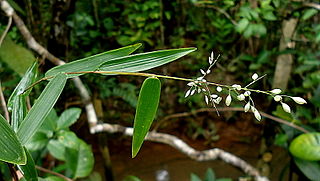
Parodiolyra is a genus of Neotropical plants in the grass family.
- Parodiolyra aratitiyopensisJ.R.Grande - Venezuela (Amazonas)
- Parodiolyra colombiensisDavidse & Zuloaga - Colombia (Caquetá)
- Parodiolyra lateralis(J.Presl ex Nees) Soderstr. & Zuloaga - Nicaragua, Costa Rica, Panama, Colombia, Venezuela, Guyana, Suriname, Ecuador, Peru, Brazil
- Parodiolyra luetzelburgii(Pilg.) Soderstr. & Zuloaga - Brazil, Colombia, Venezuela, Guyana, Suriname, French Guiana
- Parodiolyra micrantha(Kunth) Davidse & Zuloaga - Brazil, Colombia, Venezuela, Guyana, Suriname, French Guiana, Peru, Bolivia, Argentina, Paraguay
- Parodiolyra ramosissima(Trin.) Soderstr. & Zuloaga - Brazil (Bahia)

Homolepis is a genus of Neotropical plants in the grass family. They are native to Mexico, Central and South America, and the West Indies.













